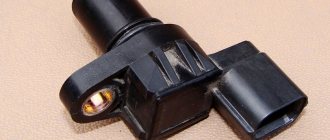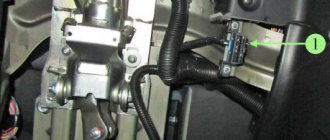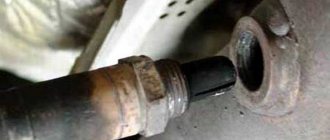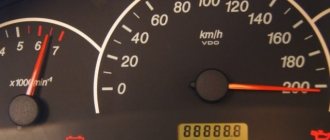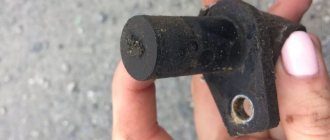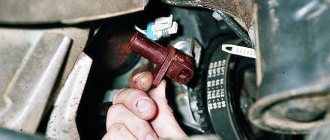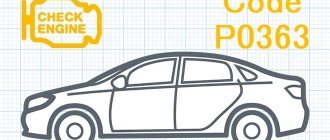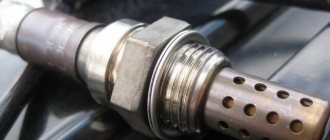Technical description and interpretation of error P0340
This diagnostic trouble code (DTC) is a generic powertrain code. The P0340 code is considered a generic code because it applies to all makes and models of vehicles (1996 and newer). Although the specific repair steps may vary slightly depending on the model.
This code indicates that a problem has been detected in the camshaft position sensor circuit. Since we are talking about a circuit, this means that the problem could lie in any part of the circuit - the sensor itself, the wiring, or the ECU. Therefore, the malfunction does not always lie in the camshaft position sensor itself.
What does error P0340 mean?
Error code P0340 means there is a problem with the camshaft position sensor.
Like many engine errors, P0340 is not a critical failure, but it significantly reduces the engine's capabilities and reduces its output, as the engine begins to operate in emergency mode.
Therefore, eliminating the error and correcting the causes of its occurrence is necessary to return the car engine to normal operation.
What does the error indicate?
Trouble code P0340 stands for Camshaft Position Sensor Circuit Malfunction. This sensor determines the position of the camshaft in a specific period of time.
Information about the position of the camshaft is transmitted to the electronic control unit, which gives the command to inject fuel from the injectors.
This ensures phased fuel injection, depending on the position of the camshaft.
Signs and conditions of an error
Like any other error, error code P0340 is diagnosed after the hazard warning light or Check Engine sign on the instrument panel comes on. After diagnostics using a scanner, an error code P0340 is displayed (Camshaft Position Sensor A Circuit in English).
There are a number of conditions that can be used to determine whether there is a problem with the camshaft sensor. These include the following signs.
- Problems with engine ignition. Often, problems with the camshaft position sensor lead to the engine refusing to start. Typically, ignition difficulties manifest themselves in the form of longer cranking of the starter, but complete ignition failure can also occur.
- Instability of engine speed at idle. Often the engine simply stalls at idle, so you have to keep the engine running at idle with the help of throttle.
- Engine tripping. The problem manifests itself in one or more engine cylinders missing ignition phases. In this case, a kind of tripping of the motor is observed when the sound of its operation changes.
- Loss of power and decrease in car dynamics. The engine picks up speed weakly, which manifests itself in a decrease in the dynamics of the car. There may also be pedal drops, problems when traveling with a load and driving uphill.
- Increased fuel consumption. Increased fuel consumption adds to the decrease in the dynamic qualities of the car. The reason for this is that the ECU switches to emergency mode, as a result of which phased fuel injection is turned off. Working in a pairwise parallel circuit increases gasoline consumption.
If, when diagnosing a vehicle, code P0340 is issued, but the indicated symptoms do not appear, then there is likely a malfunction of the ECU itself, and the error code is a false signal.
Reasons for the error
We can identify the main causes of problems with the camshaft position sensor, which manifest themselves in the form of error P0340:
- failure of the sensor itself as a result of a short circuit in the housing;
- open circuit of electrical wiring due to short circuit or corrosion of wires;
- damage to the sensor connector;
- sensor malfunction;
- ECU malfunction.
On what cars does it occur?
The error most often occurs on cars equipped with 16-valve engines, although it can also appear on 8-valve engines. This problem is especially common on cars with installed gas equipment, especially the modern fourth generation.
The LPG of such vehicles has a separate ECU. When error P0340 first appears, the operating parameters are lost, so the error will appear again and again.
As a result, you have to constantly adjust the gas equipment to the optimal injection mode, but even in this case there will be constant power losses and problems with starting.
How to fix
Before you can eliminate the error, you need to determine the source of its occurrence. If the problem lies in a malfunction of the ECU or the sensor itself, then after resetting the error it should not appear again. To reset, you can simply disconnect the battery terminals for 10-20 seconds.
If the error appears again, then you need to proceed to troubleshooting.
- The electrical wiring from the connector to the sensor and from the sensor to the ECU should be inspected for damage, breaks or corrosion. If damage is detected, the wiring must be insulated or replaced using special automotive wires with the appropriate cross-section.
- Inspect the sensor connector for mechanical damage and oxidation. If found, the connector must be cleaned or replaced.
- Check the quality of fastening of the sensor in the mounting socket. Often problems lie in incorrect installation of the sensor, incorrect selection of the meter for a specific car model, etc. The sensor is attached using a regular bolt and nut, so you also need to make sure that the fastening is secure.
Further checking is carried out using a multimeter.
With its help, you need to measure the resistance in the sensor itself, as well as in the wiring for compliance with the operating ranges (each model has individual indicators, operating parameters can be found in the car manual). If the problem lies in the wiring, then it needs to be replaced, if in the sensor itself, then it must also be replaced with a known working one.
How to Troubleshoot or Reset Trouble Code P0340
Some suggested steps to troubleshoot and fix error code P0340:
- Visual inspection of all electrical wiring and connectors in the circuit.
- Checking the integrity of the circuit wiring.
- Check the operation (voltage) of the camshaft position sensor.
- If necessary, replace the camshaft position sensor.
- Also check the crankshaft position diagram.
- Replace circuit wiring and/or connectors as necessary.
- Diagnose/replace ECU as needed.
Diagnosis and problem solving
Check the engine or review the vehicle's service history for recent timing belt repairs. As well as the camshaft sensor or crankshaft sensor.
With the ignition off, remove the chip from the camshaft sensor. Turn the ignition switch ON and verify that the tester illuminates between the ignition voltage circuit terminal 1 and ground.
We check with a tester whether there is a short circuit to ground or an open/high resistance in the ignition voltage circuit. If the circuit test passes and the ignition circuit fuse is open. Check all components connected to the ignition circuit and replace them if necessary.
Connect the tester between ground terminal 2 and ignition voltage terminal 1. Make sure the tester lights up. If the tester does not light up, check the ground circuit for an open/high resistance.
Ignition ON, test for 4.2 to 5.2 V between the signal circuit terminal 3 and the ground circuit terminal 2. If the signal range is less than specified, test the signal circuit for a short to ground or an open/high resistance. Make sure the circuit test is correct and replace the electronic module.
If above the specified range, test the signal circuit for a short to voltage. If the circuit test is correct, replace the electronic module.
Check for the following conditions if repairs were made before P0340 appeared:
- Correct installation of the camshaft sensor.
- Correct installation of the crankshaft sensor.
- Problem with the timing belt tensioner.
- Incorrectly installed timing belt.
- Jump of sprocket teeth through the timing belt.
- The crankshaft sprocket or camshaft sensor is misaligned from the top dead-end (TDC) position on the crankshaft.
If any of the above conditions occur, make the necessary repairs.
What does the error mean?
More specifically, an error code with the value P0340 indicates a malfunction in the camshaft position sensor circuit.
This sensor is used to determine the current position of the shaft at a certain point in time.
This data is transmitted to the control unit. This, in turn, transmits a command to the actuators to inject fuel through the injectors. This regulates the injection phases, which are directly related to the position of the camshaft.
Fixing this type of problem will likely require some intervention in the sensor design or wiring. And for this you need to know where it is.
On most 8-valve engines it is placed at the end of the cylinder head, near the first cylinder. If the engine is 16-valve, then you need to look for the controller on the cylinder itself.
This arrangement is explained by the fact that on gasoline internal combustion engines the sensor needs to monitor the position of the piston of this cylinder at the moment it passes top dead center. If we talk about diesel engines, then the position is fixed on all pistons.
Formation conditions
Depending on which electronic unit is used on the car, the conditions for generating the P0340 error in question may differ slightly.
But most often, to save it in the ECU memory, you need the following:
- no signals are received from the DPRV for more than 5 seconds of starter rotation;
- signals from the sensor do not reach the ECU if the engine rotates at a speed of 600 rpm or higher.
In some cars, the error is formed in one trip, in others only in 3. Because of this, diagnostics are somewhat complicated.
Symptoms of the error
On modern vehicles, the P0340 error code is one that causes the Check Engine Light to illuminate on the dashboard. But this is not the only symptom characteristic of such a malfunction.
Experts identify several signs that could potentially indicate problems with the camshaft sensor.
- Problematic ignition. If the sensor does not function or does not perform its tasks correctly, the engine may not start. Ignition problems manifest themselves as the need to turn the starter longer than usual. But it is possible that the engine will not start at all.
- Instability of speed. This appears at idle. The engine may stall; you have to keep it running by pressing the gas pedal.
- The internal combustion engine is tripping. Another sign in which the cylinders miss the ignition phases. Signs resembling tripling appear. The engine sound changes.
- Loss of power and dynamics. The engine begins to gain speed worse, the car accelerates more slowly. Possible failures of the gas pedal, difficulties in accelerating uphill and when the car is loaded.
- Increased appetite DVS. Fuel consumption increases, while at the same time the dynamics deteriorate. This is due to the ECU switching to emergency mode. Phased injection stops working.
If the car does not exhibit such symptoms, but error P0340 is still recorded in the unit’s memory, there is probably a problem with the ECU itself. An error is the result of a false positive.
Therefore, here we will have to resolve the issue with the faulty control unit.
Reasons for appearance
There are several reasons why error P0340 may occur.
- Damage to the wiring on the sensor side. The wiring wears out and breaks occur. Such controllers usually have 3 wires. This is a signal wire, ground and power. Due to location, mechanical influences and the influence of other factors, the wires are frayed and no signal is received through them. Breaks are usually observed near terminals and contacts. It is also possible that the insulation on the wires may be damaged, leading to a short circuit. As a result, the sensor works, but sends incorrect information to the electronic unit.
- Sensor damage. Structurally, the DPRV is a fairly reliable and simple device. Because of this, its failure is comparatively rare. But if such an error appears, it would not be superfluous to check the sensor for integrity.
- Problems with the ECU. This is a rare phenomenon, since when the ECU fails, a whole scattering of errors appears. But this option cannot be excluded. Most often, the problem can occur after the unit was incorrectly flashed, which caused the corresponding problems.
- The last place in terms of frequency of manifestations is occupied by sensor breakdown and incorrect installation. Sometimes it’s enough just to try to insert the sensor more firmly into its mounting socket, and everything will work.
None of the reasons can be excluded until they are confirmed or refuted. To do this, you should carry out diagnostic measures and at the same time try to eliminate the problem.
On which cars does the error appear?
It would be wrong to say that only Nissan vehicles display the P0340 error. This is a fairly common phenomenon affecting a number of makes and models of cars.
Statistics show that most often error code P0340 appears on cars that have a 16-valve internal combustion engine under the hood. But there is also a possibility of its manifestation on cars such as VAZ 2110 or VAZ 2114, VAZ Niva, equipped with 8-valve engines.
Experts also note that this is a typical malfunction for gasoline internal combustion engines converted to 4th generation LPG. There is a separate ECU here. The first time this error occurs, the settings for the operating parameters of gas-cylinder equipment are violated. Because of this, car owners have to constantly repeat settings if the cause of the error is not eliminated.
The cars for which error P0340 is most relevant include the following makes and models:
- Mitsubishi Lancer;
- Chevrolet Cruze;
- Kia Spectra;
- Nissan Almera;
- Lada Kalina;
- Lada Priora;
- Toyota Corolla;
- Opel Vectra;
- classic VAZ, etc.
If a scanner check shows the presence of a corresponding error, measures should be taken to eliminate it. To do this, it is necessary to carry out diagnostic measures with a parallel solution to emerging problems.
Diagnosis and elimination of errors
The problem is solved largely depending on the specific make and model of the car and the year of its manufacture.
But the algorithm of actions for all machines will be approximately the same. It can be represented as follows:
- Using a scanner, connect to the ECU, check the unit's memory for recorded and saved errors. If there are no other errors, you can simply reset P0340 first. They do this in 2 ways. Either through the scanner itself, or by resetting the negative voltage to the battery for 10-20 seconds. If after starting the internal combustion engine the error disappeared, it was a false positive or a problem on the part of the control unit. If the error appears again, you need to proceed further.
- Check the latch that ensures contact of the chip on the sensor body. Sometimes it breaks or wears out. As a result, contact between the wires is partially or completely lost.
- Check how securely the sensor itself is installed in its socket. In many cars it is mounted using a nut and a certain tightening torque. A torque wrench is needed here.
- Make sure the sensor matches your vehicle. DPRVs may differ in their shape, location of contacts, and sizes. If the sensor does not match the machine, related problems arise. This situation is typical for those who recently replaced the sensor and such an error appeared, or purchased a used car with such a problem. Match the part to your vehicle and order a new controller if necessary.
- If possible, install a known-good position sensor. This will allow you to understand whether the problem is really there or whether there are other faults that cause the P0340 error to appear.
- Visually check all contacts and terminals. Some areas may show signs of oxidation and rust. They negatively affect the quality of contacts. Clear them and try again. Perhaps the error will go away.
- Using a multimeter, put it in continuity or insulation resistance mode, go through all the wires connecting the ECU and the camshaft sensor. Most often there are 3 wires. Check their integrity, the resistance value between the wires and between each wire and the ground taken from the body. If the integrity is broken, you will have to change the wiring. Trying to restore it with duct tape is not the best idea in such a situation.
- Check the integrity of the sensor. Since its mechanical damage is very rare, the occurrence of such a problem is unlikely. But if all previous theories were destroyed during diagnostics, only the least probable faults remain to be checked. When purchasing a new sensor, give preference to originals purchased through trusted suppliers or an official dealer. Now there are a large number of fakes and low quality sensors on the market. Such parts should be avoided.
- If the sensor is working, then there is only one option. These are problems on the control unit side. It is not recommended to interfere with its design and settings with your own hands. The component is very important, complex and expensive. It is better to entrust ECU diagnostics to specialized specialists.
On which cars is this problem most common?
The problem with the P0340 code can occur on different machines, but there are always statistics on which brands this error occurs more often. Here is a list of some of them:
- Alfa Romeo
- Audi (Audi A4, Audi A6)
- BMW
- Chery (Chery Indis, Kimo, Tiggo, Fora)
- Chevrolet (Chevrolet Aveo, Cruz, Lanos, Lacetti, Orlando, Epica)
- Chrysler (Chrysler Voyager, PT Cruiser, Sebring)
- Citroen (Citroen Xsara Picasso, Jumper)
- Daewoo (Daewoo Matiz, Nexia)
- Dodge (Dodge Durango, Caravan, Neon, Stratus)
- Fiat (Fiat Albea, Doblo, Ducato, Punto, Stilo)
- Ford (Ford Galaxy, Kuga, Mondeo, Transit, Fiesta, Focus, Fusion, Escape)
- Honda (Honda Civic)
- Hyundai (Hyundai Accent, N1, Getz, Matrix, Santa Fe, Solaris, Sonata, Terracan, Tucson, Elantra, ix35)
- Infiniti (Infiniti fx35, fx45, m35)
- Jeep (Jeep Grand Cherokee)
- Kia (Kia Bongo, Carnival, Optima, Picanto, Rio, Sid, Sorento, Spectra, Sportage, Cerato)
- Land Rover (Land Rover Range Rover, Freelander)
- Lexus (Lexus rx330)
- Mazda (Mazda 3, Mazda 6, Mazda 626, Mazda cx5, Mazda cx7, Tribute)
- Mercedes (Mercedes c180, w203, w204, w212)
- Mitsubishi (Mitsubishi Airtrek, Outlander, Galant, Karizma, Colt, Lancer, Montero, Pajero, Space Star, L200)
- Nissan (Nissan Almera, Bluebird, Beetle, Cabstar, Qashqai, Cube, Maxima, March, Micra, Murano, Navara, Note, Pathfinder, Primera, Sunny, Skyline, Teana, Tiida, X-Trail)
- Opel (Opel Agila, Antara, Astra, Vectra, Vivaro, Zafira, Corsa, Meriva, Omega)
- Peugeot (Peugeot 406, 807, 3008, Boxer)
- Renault (Renault Megane, Scenic, Traffic)
- Rover (Rover 75)
- Saab
- Skoda (Skoda Octavia)
- Ssangyong (Sanyeng Aktion, Kyron)
- Subaru (Subaru Outback, Impreza, Legacy, Forester)
- Suzuki (Suzuki Wagon, Jimny, Grand Vitara, Ignis, Liana)
- Toyota (Toyota Avensis, Vitz, Camry, Corolla, Land Cruiser, Prado, Prius, Highlander, Hilux, Yaris)
- Volkswagen (Volkswagen Golf, Passat)
- Volvo (Volvo s40)
- Vortex (Vortex Tingo, Estina)
- Volga Cyber
- VAZ 2109, 2110, 2111, 2112, 2114, 2115
- Lada Vesta, Kalina, Niva, Priora
- UAZ Bukhanka, Patriot, Hunter
Other errors can sometimes be encountered with fault code P0340. The most common ones are: P0016, P0108, P0113, P0118, P0138, P0158, P0335, P0345, P0351, P0365, P0443.
Reasons for appearance
There are several reasons why error P0340 may occur.
- Damage to the wiring on the sensor side. The wiring wears out and breaks occur. Such controllers usually have 3 wires. This is a signal wire, ground and power. Due to location, mechanical influences and the influence of other factors, the wires are frayed and no signal is received through them. Breaks are usually observed near terminals and contacts. It is also possible that the insulation on the wires may be damaged, leading to a short circuit. As a result, the sensor works, but sends incorrect information to the electronic unit.
- Sensor damage. Structurally, the DPRV is a fairly reliable and simple device. Because of this, its failure is comparatively rare. But if such an error appears, it would not be superfluous to check the sensor for integrity.
- Problems with the ECU. This is a rare phenomenon, since when the ECU fails, a whole scattering of errors appears. But this option cannot be excluded. Most often, the problem can occur after the unit was incorrectly flashed, which caused the corresponding problems.
- The last place in terms of frequency of manifestations is occupied by sensor breakdown and incorrect installation. Sometimes it’s enough just to try to insert the sensor more firmly into its mounting socket, and everything will work.
None of the reasons can be excluded until they are confirmed or refuted. To do this, you should carry out diagnostic measures and at the same time try to eliminate the problem.
we look for reasons and reset ⋆ I Love My Car
In fact, this sensor structurally inherits the Hall sensor used in all cars with an electronic ignition system. However, it is a more complex electronic system, located at the secondary level of the bridge circuit, which includes an op-amp and an output stage. There is no need to be afraid of electronic systems, since even the simplest multimeter will allow us to at least approximately determine the culprit.
Phase sensor connection diagram
First, let's check if power is supplied to the sensor. To do this, with the ignition on, check the voltage on the first and last legs of the connector. Naturally, under normal conditions it should be about 13 V. After this, it may turn out that the sensor itself has failed, or, if there is no signal, we are looking for a break or poor contact in the wiring.
Secondly, we check the sensor using the same scheme as a hall sensor of the simplest design. To do this, when power is applied to the contacts, we hold a metal object in front of the sensitive element of the sensor. The ohmmeter needle should deflect. If this does not happen, the sensor has failed.
Thirdly, we connect the multimeter probes to the sensor installed on the engine - to the outer terminals. (One for power, the second for output to the ECU) We crank the engine with the starter and look at the voltmeter readings. As a rule, if the sensor is working properly, the nominal values will vary within 0.3-4 V. If the rating is higher or lower than normal, the sensor must be replaced.
Preliminary diagnosis
Before you try to solve the problem, you need to make sure that error P0340 is really present. Recheck using the diagnostic scan tool. Turn off the car's power for 10–20 minutes and reconnect the device. If the error disappears, then there may be a malfunction in the DPRV or ECU.
Next, you need to make sure that each element of the circuit is working properly:
- Check the tightness of the sensor contacts - it is correctly and securely attached to the mounting location with the latch. The mount should not be chipped, the correct sensor model has been installed, which exactly fits in shape and size, and the nuts must be tightly tightened.
- Assess the condition of the wiring and terminals. Initially, check visually for correct connection, absence of breaks and oxidation. Moisture or dirt can cause poor contact quality.
- Make sure there is current in the circuit. Using a multimeter, measure the resistance of the three main wires.
- Check the electronic control unit. In this case, it is recommended to contact a car service specialist, since in practice it is quite difficult to carry out independent diagnostics. You will need specialized devices - an oscilloscope, diagnostic software and a cable for testing using the KWP2000 protocol.
This is interesting: Reasons why the machine twitches while driving
Replacing the device
Dismantling the part is not difficult. We find it behind the air filter. The phase sensor housing is secured with a bolt.
First, disconnect the terminals from the battery. In this case, the electronic unit will be de-energized. The control unit memory is reset to zero.
If you don't turn off the on-board network, you won't feel the difference. After replacement, the unit will maintain the same mode as with a faulty phase sensor. Process control returns to normal only after several engine starts.
Tools and materials for removing the sensor are available in the arsenal of every motorist. You need to prepare a key for ten, sealant, alcohol, rags. It is convenient to unscrew the fastening bolt using a socket wrench. Take the sealant from ZOLLEX. It is designed for temperatures up to 350°C.
Replacing the sensor will take 10 minutes. First of all, disconnect the wire block from the phase sensor. To do this, you need to bend the latch with one hand and pull out the wiring with the other. Next, unscrew the only bolt. It's on the back side. We take out the body of the spare part.
Do not apply great force when removing the DF.
Moreover, you should not use impact-type locksmith tools. The plastic housing may crack. Residues will fall inside.
Before installing a new device, you need to clean the seat. Apply a thin layer of sealant to the joining ring. Let stand for a few minutes. We put the camshaft sensor in place. We tighten the bolt.
Feel free to connect the wires. Oxidized contacts on the plug are cleaned with alcohol. The pinout of the wires will not be disturbed. The VAZ 2115 has a lock. When connecting the terminal block, watch the latch. The latch should engage.
That's all. Don't forget to connect the terminal to the battery. Turn on the ignition. We start the car and watch the instrument panel. The indicator should go out within a second after starting. This means that the replacement was successful.
Of course, the main test of the VAZ 2115 will take place on the road. Therefore, we turn on the gear and enjoy the growl of the engine. If the problem is solved, the engine will restore its former agility, and the car will restore its acceleration dynamics.
Modern cars are equipped with smart electronics. It ensures both the performance of the on-board system itself and control of the operation of the mechanical joints of the automobile body. On cars with an injection engine, in particular the VAZ 2114, Priora, Kalina and the rest of the “ten” family, there is a camshaft sensor, which we will talk about today; as an example, we will consider the VAZ 2114 8-valve timing sensor.
Recommended Tools to Troubleshoot P0340
- Reading error codes and engine parameters - LAUNCH X431.
- Car charger - this or similar.
- To measure wiring use a digital multimeter.
- Electrical contact cleaner.
- Advanced diagnostics - oscilloscope.
Previous post Error P0562 - what it means, symptoms, causes, diagnosis, solution
Next entry Error P0137 - what it means, symptoms, causes, diagnosis, solution
